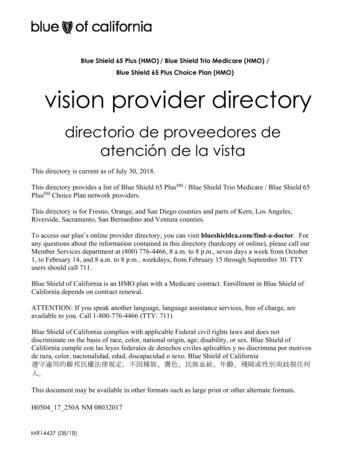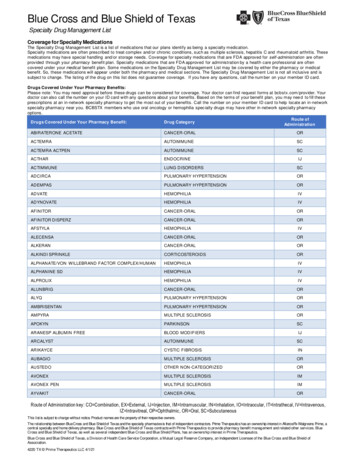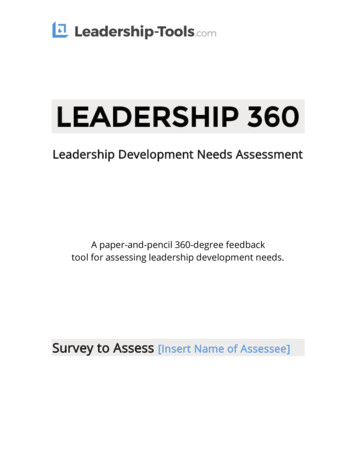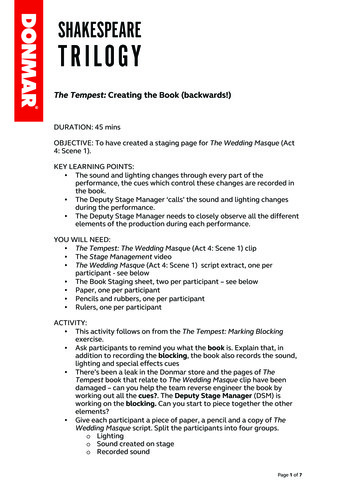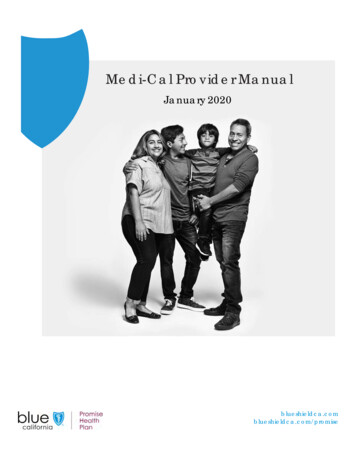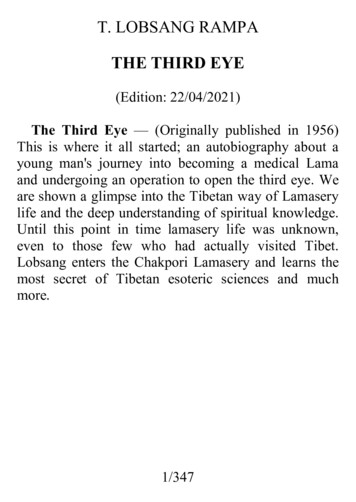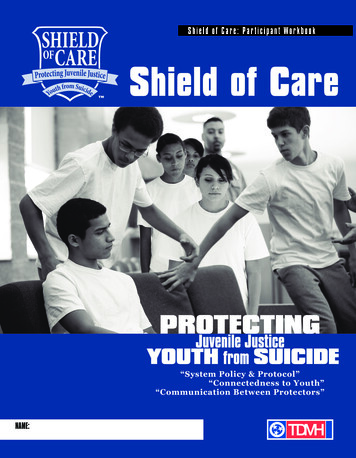
Transcription
S h i e l d o f C a r e : P a r t i c i pa n t W o rk b ook Shield of Care“System Policy & Protocol”“Connectedness to Youth”“Communication Between Protectors”NAME:
2SHIELD OF CARE: Participant Workbook
System Policy and ProtocolConnectedness to tion Between ProtectorsPROTE CTOR3SHIELD OF CARE: Participant Workbook
IndexIntroductory Letter and Self Care Resources. 5Section I: Introduction to the Shield of Care. . . 6Section II: Overview. 7Section III: Shield of Care ModelOverview. 9Part A: “Seeing”. 10Part B: “Protecting”. 19Part C: “Listening”. . 21Part D: “Assessing”.24Part E: “Networking”. 27Section IV: After a Suicide. 30Youth Story CardsVictoria. 32Jake. 34Haley. . .36David. . 38Section V: Glossary.404SHIELD OF CARE: Participant Workbook
Self Care Guidehank you for joining us in this suicide prevention training.Ttraining will be a beneficial experience for you.We hope thisIn this training, we will be learning about the prevalence of suicide in juvenilejustice facilities, reflecting on our attitudes about suicide, and learningstrategies for preventing suicide in our facility.We know that suicide can be a difficult topic to think about and discuss.Learning or talking about suicide prevention can be especially difficult forthose who have lost a loved one to suicide. For this reason, if the topic getstoo personal or intense for you, feel free to quietly step out of the training andregroup. The trainers may also be able to assist you briefly during a break andtalk with you about additional resources available.If you would like additional one-on-one time to talk with someone about thethoughts/emotions you experienced during this training, you may contact anyof the resources below. These resources in your community may also be used tofind out more information about suicide prevention and/or as referral resourcesif someone you know is thinking of suicide.National Suicide Prevention Resources: National Suicide Prevention Lifeline: 1-800-273-TALK (8255) American Association of Suicidology (AAS): http://www.suicidology.org American Foundation for Suicide Prevention (AFSP): http://www.afsp.orgNote: If you’ve lost a loved one to suicide, AFSP and AAS have a list ofsurvivor support groups listed by state. National Organization for People of Color Against Suicide (NOPCAS):http://www.nopcas.com Suicide Prevention Resource Center (SPRC): http://www.sprc.orgAdditional National Resources: Local*****Poison Control: 1-800-222-1212National Center on Institutions and Alternatives: http://www.ncianet.orgGatekeeper Support Tools: http://www.gatekeeperaction.orgSuicide Prevention and Referral Resources:Your supervisorAnother trusted co-workerIf you are unable to complete this training due to an intense emotional concern, pleasecoordinate alternative training options with your supervisor.5SHIELD OF CARE: Participant Workbook
Section I: IntroductionIntroduction6SHIELD OF CARE: Participant Workbook
Section ll: OverviewOverviewWhat is the prevention potential of this information?How can you maximize the prevention potential ofthis information given your role?What is the prevention potential of this information?How can you maximize the prevention potential ofthis information given your role?IIAttention Deficit/Hyperactivity Disorder- is adevelopment disorder. “Symptoms include difficultystaying focused and paying attention, difficultycontrolling behavior, and hyperactivity (overactivity).” (NIMH)Conduct Disorder – “is a repetitive, persistentpattern in children or adolescents of violating therights of others, rules, or social norms.” (SPRC)Post Traumatic Stress Disorder – “A commonanxiety disorder that develops after exposure to aterrifying event or ordeal in which grave physicalharm occurred or was threatened.“ (WikEd)Psychotic Disorder – “A mental disorder inwhich a person’s contact with reality is impaired.During a psychotic episode a person’s thoughtpatterns are often confused and disorganized. Theyfrequently experience such signs and symptomsas delusions, hallucinations and paranoia.”(Psychiatrynetworks.com).(Source: SPRC/AFSP Toolkit for Schools)SHIELD OF CARE: Participant Workbook7
Section ll: OverviewWhat is the prevention potential of each of thestatistics on this slide?Statistic #1Statistic #2Statistic #3What is the prevention potential of this information?How can you maximize the prevention potential ofthis information given your role?What is the prevention potential of the informationfrom our own facility?What can you do in your role to maximize thisinformation?8SHIELD OF CARE: Participant Workbook
Section ll: OverviewII9SHIELD OF CARE: Participant Workbook
Section lll: Shield of Care ModelPART A:SEEING1. SEEING ATTITUDESA. Activity: Suicide Attitudes SurveyDirections: Below, you will see several statements about suicide. After reading eachstatement, decide whether you 1) Strongly Disagree, 2) Disagree, 3) Neither Agree NorDisagree, 4) Agree, or 5) Strongly Agree. There are no right or wrong answers, only whatyou think or believe. Use the answer grid provided to record your responses.Strongly DisagreeNeitherAgree StronglyDisagreeAgree NorAgreeDisagree1. There isn’t much I can do to stop a youthfrom killing him/herself.123452. Suicidal behaviors are irrational.123453. Youth in secure facilities who threaten orattempt suicide only want attention.123454. Suicide is wrong.123455. I may choose not to intervene with asuicidal JJ youth so I do not become liable.123456. If a youth I work with in the facilityconsiders or attempts suicide, I have failed athelping that youth.123457. The facility environment increases JJyouth's risk for suicide.123458. Suicide prevention training can help mesave lives of JJ youth.123459. JJ youth think about suicide more oftenthan non-incarcerated youth.1234510. Youth in secure facilities have fewerreasons to live than non-offending youth.1234511. A staff person who intervenes when ayouth is considering suicide becomes legallyresponsible for that youth's life or death.1234512. I feel comfortable discussing suicide issueswith youth in JJ facilities.1234510SHIELD OF CARE: Participant Workbook
Section lll: Shield of Care ModelOnce you’ve completed the survey, answer the following questions:1. Does attitude #1 help or hinder a caregiver’s ability to prevent suicide?Why?/Why not?PART A:SEEING2. Does attitude #2 help or hinder a caregiver’s ability to prevent suicide?Why?/Why not?III3. Does attitude #3 help or hinder a caregiver’s ability to prevent suicide?Why?/Why not?4. Does attitude #4 help or hinder a caregiver’s ability to prevent suicide?Why?/Why not?11SHIELD OF CARE: Participant Workbook
Section lll: Shield of Care ModelPART A:SEEINGII. SEEING onshipswith youthin general sothat it willA. Thinking Patterns1. Rigid thinking – This is an all or nothing thinking pattern. Typically if X does ordoesn’t happen, I will do Y. “If my dad doesn’t come see me by my birthday, I’m givingup.”be easierfor themto acceptyour help2. Overgeneralizing – Taking an incident/experience/feeling, etc. and extending it toan unreasonable conclusion. For example, a family member may have missed a visit dueto an emergency, and you hear the youth say, “See, she missed the meeting. She doesn’tgive a crap and no one else does either.” “I can’t do this. I can’t do anything right.” “I’vebeen in this stinking place for years, and no one will ever talk to me.”in a crisissituation.Help allyouth buildconfidencein theirability tosolve smallerproblems. In3. Catastrophizing – Taking something and making it a catastrophe - “I have nothingto look forward to. I might as well be dead.” “People don’t care about anyone exceptthemselves.”4. Terminal statements – Any statement that hints of death or suicide. “I might aswell just kill myself,” “I just can’t take it anymore.”(Source: Mace et al., 2007)doing so, itwill be easierfor them tosolve largerproblems.12SHIELD OF CARE: Participant Workbook
Section lll: Shield of Care ModelIII. SEEING RISKProtective factors are characteristics that make it less likely that individuals willconsider, attempt, or die by suicide.PART A:SEEINGThese factors are largely biological, psychological, social and environmental.Biological: Intellectual ability, personality/temperamental traits, and toughness,Psychological: Resilience, motivation, humor and perceptions of self; emotionalattributes - emotional well-being, life satisfaction, optimism, happiness, trust,optimism, hope; cognitive; spiritual attributes, and attributes of post-traumaticgrowth.Social: Interpersonal skills, interpersonal relationships, connectedness, and socialsupportEnvironmental: Positive life events and socioeconomic status.III(Bell, et al., 2005)For more information on protective factors, tml13SHIELD OF CARE: Participant Workbook
Section lll: Shield of Care ModelPART A:SEEINGA. HIGH RISK PERIODS OF CONFINEMENT(Sources: Hayes, 2009; Hayes, 2007)Room ConfinementDeath of Another Youth in the FacilityParents Threat of/Failure to VisitFailure in the ProgramRidicule from PeersSevere Guilt or Shame about OffenseSexual/Physical AssaultRoom confinement is a sanction that can have deadly consequences and should be closelyscrutinized and utilized judiciously.In fact, over 50% of all juvenile suicides occur while the youth is under roomconfinement status.This is a very significant finding. Placement of a youth on confinement status may triggerself-injurious behavior.14SHIELD OF CARE: Participant Workbook
Section lll: Shield of CarePART A:SEEINGB. SUICIDE WARNING SIGNS(Sources: SPRC; AFSP; Joiner, 2005)Warning signs are those signs that indicate the possibility of an imminent suicidal crisis.This list includes warning signs most commonly cited in a wide body of research. Take allsuicidal behavior seriously.Ideation - Thoughts of suicide. Ideation can be expressed through talking,gesturing, writing and drawing.IIIMay also be exhibited through Terminal Statements - “I won’t be a problem foryou much longer.” “I wish I were dead.” “I’m going to kill myself.” “It’s no use.”Having a Suicide PlanActively Seeking Access to Suicide MeansUnbearable Pain often as a Result of a Loss/Crisis - death of a loved one,divorce, break-up, peer rejection or the loss of anything that is of great value tothe teen especially in conjunction with depressionPerceived Lack of Resources – Internal and ExternalPerceived Expendability – Belief that no one would miss the teen, the teen’sexistence doesn’t matter, or that people would be better off without him/herIncreased/Persistent or More Pronounced Signs of Depression (especiallyanger, sadness to misery, withdrawal/isolation, lack of interest in usual activities)Making final arrangements, saying goodbye as if s/he won’t see someone elseagainGiving Away PossessionsRefusing help, feeling “beyond help”Becoming suddenly cheerful after a period of depression – this may mean that15SHIELD OF CARE: Participant Workbook
Section lll: Shield of Care ModelPART A:SEEINGthe teen has already made the decision to escape all problems by ending his/herown lifeFeelings of hopelessness or purposelessnessBullying and/or harassment and/or extreme embarrassment/humiliationC. SUICIDE RISK FACTORS(Source: SPRC)Risk factors are those signs that predispose someone to suicide. The following listincludes those risk factors most commonly cited in research.Biopsychosocial Risk Factors Mental disorders, particularly mood disorders, schizophrenia, anxiety disordersand certain personality disorders Alcohol and other substance use disorders Hopelessness Impulsive and/or aggressive tendencies History of trauma or abuse Some major physical illnesses Previous suicide attempt Family history of suicide Environmental risk factors Job or financial loss Relational or social loss Easy access to lethal means Local clusters of suicide that have a contagious influence16SHIELD OF CARE: Participant Workbook
Section lll: Shield of CareSociocultural Risk Factors; Lack of social support and sense of isolation Stigma associated with help-seeking behavior Barriers to accessing health care, especially mental health and substanceabuse treatment Certain cultural and religious beliefs (for instance, the belief that suicide isa noble resolution of a personal dilemma) Exposure to, including through the media, and influence of others whohave died by suicide Problems with the law/involvement with the juvenile justice systemAlthough the majority of people who have depression do not die by suicide, severedepression does significantly increase the risk of suicide.D. SIGNS OF DEPRESSION(Sources: DMV IV; National Association of School Psychologists)PART A:SEEINGIIIIs itDepression?Likely if thechanges persistfor longer thantwo weeks; thesigns continueto worsen;attempts torelieve thesymptoms areunsuccessful;Behavioral Changesand/or the Depressed, angry or irritable mood most of the day, nearly every day Diminished interest or pleasure in all, or almost all, activities Diminished ability to concentrate; or indecisiveness Change in school performance (global drop in grades) Change in attitude about school Substance abuse Constant feelings of worthlessness or excessive or inappropriate guilt Problems in relationships Recurrent thoughts of death (not just fear of dying), recurrent suicidal ideation,a suicide attempt or a specific plan for committing suicide Refusal to attend or participate in school Outbursts of shouting, complaining, unexplained irritability, or cryingSHIELD OF CARE: Participant Workbooksymptomsinterfere witheverydayactivities.17
Section lll: Shield of CarePART A:SEEING Withdrawal, social isolation, and poor communication Extreme sensitivity to rejection or failure Unusual temper tantrums, defiance, or oppositional behavior Chronic boredom or apathyPhysical Symptoms Significant weight loss or gain or decrease/increase in appetite Difficulty sleeping or excessive sleeping Agitated - always moving Psychomotor retardation Moping around nearly every day Vague physical complaints; constant fatigue or lack of energyE. Challenging behaviorDepressed or suicidal youth may challenge you with their behavior particularly if angeris a predominant sign of depression. Remember that this behavior may be driven by anillness rather than the desire to make your life difficult or to challenge your authority.F. Activity: Video Viewing TasksPlease note any of the following:1. Signs of depression:2. Risk factors of suicide:3. Warning signs of suicide:18G. Activity: Youth Story Cards– Refer to the “Seeing” Questions on the Youth StoryCard in the Appendix for this Exercise.SHIELD OF CARE: Participant Workbook
Section lll: Shield of CarePART B:PROTECTING“PROTECTING”I INTERVENTIONSA. Responding to a Suicide AttemptIIIRoom confinement is a sanction that can have deadly consequences and should be closelyscrutinized and utilized judiciously. In fact, over 50% of all juvenile suicides occur whilethe youth is under room confinement status. This is a very significant finding. Placementof a youth on confinement status may trigger self-injurious behavior.Notes On Our Facility’s Observation Levels:19SHIELD OF CARE: Participant Workbook
Section lll: Shield of Care ModelPART B:PROTECTINGB. Activity: Youth Story Cards – Refer to the “Protecting” Questions on the Youth StoryCard in the Appendix for this Exercise.C. Activity: Policy ReviewPlease take out your copy of the policies and procedures and stay in your groupsto discuss the following exercise and questions:In what ways are these policies helpful to you as a caregiver when thinking aboutprotecting a youth at risk for suicide?In what ways is your role limited by policy in regard to protecting youth at risk forsuicide?20SHIELD OF CARE: Participant Workbook
Section lll: Shield of Care ModelPART C:LISTENING“LISTENING”A. ReflectionIIIB. Activity: Listening – Individual WorkDirections: Paraphrase the following statement. Avoid pitfalls!“No one understands. No one will ever understand.”Paraphrase here21SHIELD OF CARE: Participant Workbook
Section lll: Shield of Care ModelPART C:LISTENINGC. Activity: Listening – Pair WorkObjective: The person in the role of listener will practice listening skills in thecontext of the speaker’s aggravation driving experience.Directions: The listener will practice paraphrasing the speaker’s experience asclosely as possible while resisting the temptation of offering a solution, sharing asimilar experience or criticizing the other driver.1. Individually – Think of something another driver did that really made you mad.Write it here2. Begin the exercise with the statement below.Open with “You look really [upset].”3. Allow your partner to discuss the experience4. Practice using the following:“So you’re saying ”“What I hear you saying is Mirror the statement – Near word for word restatement.22SHIELD OF CARE: Participant Workbook
Section lll: Shield of Care Model5. Once you’ve reflected the experience, follow it up with. “I’m sorry thathappened to you.”PART C:LISTENINGWait for trainer to debriefD. Activity: Youth Story Cards – Refer to the “Listening” Questions on the YouthStory Card in the Appendix for this Exercise.E. Activity: Policy ReviewIIIPlease take out your copy of the policies and procedures and stay in your groupsto discuss the following exercise and questions:In what ways are these policies helpful to you as a caregiver when thinkingabout listening to a youth at risk for suicide?23SHIELD OF CARE: Participant Workbook
Section lll: Shield of Care ModelPART D:ASSESSING“ASSESSING”A. Asking about suicide1. What are some ways to ask directly about suicide?B. Listening and AskingExample of using listening skills and asking the question:S Staff, Y youthS - I see that you’re really angry. What’s going on?Y – My mom didn’t show up again.S – You’re saying that your mom didn’t show up again. I can understand whyyou would be angry about that.Y – She doesn’t care. No one does. I won’t be a problem for her much longer.Based on the above example, answer the following questions:1. What might lead you to think that suicide is an issue?2. Would it be too soon to ask about suicide?243. How would you do it?SHIELD OF CARE: Participant Workbook
Section lll: Shield of Care ModelPART D:ASSESSINGIIIC. Activity: Video Viewing TasksDirections: In your groups, decide who will be focusing on seeing, who will befocusing on protecting, who will be focusing on listening and who will be focusingon assessing. Once these roles are assigned, take notes in your assigned sectionbelow:“Seeing” Tricia1. Note any signs of depression, risk factors/warning signs for suicide or high riskperiods of confinement here.“Protecting” Tricia2. Note any protecting actions here.“Listening” to Tricia3. Note examples of how Darlene listened here“Assessing” Tricia4. How did Darlene determine Tricia was suicidal?SHIELD OF CARE: Participant Workbook25
Section lll: Shield of Care ModelPART D:ASSESSING5. If you remember the question, please note it here.When the video is over, wait for instructions from your trainer.Discuss the following questions.1. What prompted Darlene to begin talking with Tricia?2. How did Darlene “protect” Tricia’s emotional safety?3. How did Darlene physically protect Tricia?4. What specific warning sign directly asking and led to Darlene asking directlyabout suicide?D. Activity: Youth Story Cards – Refer to the “Assessing” Questions on the YouthStory Card in the Appendix for this Exercise.E. Activity: Policy ReviewPlease take out your copy of the policies and procedures and stay in yourgroups to discuss the following questions:What does the policy say about assessing a youth at risk for suicide?In what ways are these policies helpful to you as a caregiver when thinking aboutassessing a youth you perceive to be at risk for suicide?In what ways is your role limited by policy in regard to assessing a youth youperceive to be at risk for suicide?26SHIELD OF CARE: Participant Workbook
Section lll: Shield of Care ModelPART E:NETWORKING“NETWORKING”IIIA. Activity: Video Viewing Tasks1. How does the staff work together to help Eddie’s?2. At what point did Sal does stand back and let Nick continue?3. How does Nick help protect Eddies’ emotional safety?4. How does Nick make the referral easier for the mental health staff?B. Activity: Youth Story Cards – Refer to the “Networking” Questions on the YouthStory Card in the Appendix for this Exercise.27SHIELD OF CARE: Participant Workbook
Section lll: Shield of Care ModelPART E:NETWORKINGC. Activity: S-PLAN ReviewFactsUse prompts below to list five things you either learned or reviewed in thistraining that could help you save a life. Be as specific as possible. An example isprovided below to help you get started.Example:An important FACT about suicide is: Suicide is the THIRD leading cause of deathamong youth ages 10-24.In this training, I learned (or reviewed) that: . . .1. An important FACT about suicide is:2. My OPINION about suicide includes the attitude/belief that:3. Youth may demonstrate RISK FACTORS/WARNING SIGNS of suicide. One is:4. Youth may demonstrate PROTECTIVE FACTORS against suicide. One is:5. The MOST IMPORTANT thing(s) I learned in training that will help me save alife is:Responding to RiskUse the questions below to think about ways you can apply what you learned in trainingto respond to youth at risk for suicide.28SHIELD OF CARE: Participant Workbook
Section lll: Shield of Care Model1. How is suicide risk most likely to be displayed in the Juvenile Justicepopulation at your facility?PART E:NETWORKINGa) A youth might say something likeb) A youth might do something like2. Think about your role in your particular juvenile justice facility (e.g., “SecurityOfficer;” Corrections Teacher). What parts of the Shield of Care model areyou most equipped/able to perform in your work role? What do your policiesand procedures say about helping suicidal youth?IIIShield of Care Action PlanAny of the youth with whom you work could be at risk of suicide. Fill in the blanks withspecific information related to the S-PLAN to demonstrate how YOU will help a youth atrisk.1. S –2. P –3. L –4. A –5. N –D. Activity: Busting BarriersWhen I,(Your Name Here)(Your Name Facility), encounter potential barriers to suicide prevention at, I will use these Barrier Busting Techniques to help save a life.Potential Barrier to Helping Someone At Risk of Suicide:1.2.29SHIELD OF CARE: Participant Workbook
Section IV - After a Suicide3.Barrier Busting Technique:1.2.3.AFTER A SUICIDE30SHIELD OF CARE: Participant Workbook
Section IV - After a SuicideAFTER ASUICIDEA. Self Care - Watch for Signs of StressTension: Physical and emotional tension, being excessively hyper, unable to relax or sitstill for very long, muscle tremors or twitches.Nausea: Especially during or immediately after the incident.Body temperature regulation: Profuse sweating or chills at unusual times.IVSleep disturbances: Either the inability to fall asleep, disruptive dreams or nightmaresor waking up earlier than usual.Fatigue: Always tired. No pep or energy.Intrusive thoughts or memories: Thinking about the incident or some recurringmemory obsessive thoughts about when you don’t want to.Negative feelings/Crying: Unpleasant feelings that may come without warning, suchas profound sadness, helplessness, fear, anxiety, anger, rage, discouragement, frustrationor depression.A feeling of vulnerability or lack of control: Feeling exposed to threats, not incontrol of one’s life, experiencing paranoia.Interpersonal problems: increased irritability, insensitivity, blaming others,distancing from others.Substance Abuse: “Self-medication” can be a symptom of stress.Compulsive behavior: Increased problems such as compulsive eating or otheruncontrolled, repetitive behaviors.Self Blame: Usually this fixes on some particular aspect of the incident. A sense ofhaving lost self-value or diminished self-esteem. “I could have done this or should havedone that.”(Used with permission from the California Department of Corrections and Rehabilitation)31SHIELD OF CARE: Participant Workbook
1VICTORIASTORYVictoria picked up her tray in the cafeteria line and looked for a placeto sit in the dining room. She saw a seat at a table near Jennifer,Latisha and Monica, who always seemed to be having fun, but itseemed like they suddenly stopped talking and looked down at theirtrays as she approached, so she walked past and sat at the very nexttable.She couldn’t tell what they were whispering about, but they stoppedagain when she got up to get more water. She was drinking a lot ofwater the last day or so because her anti-depressant was making hermouth so dry. She hasn’t had much appetite, and you’ve noticed thatshe hasn’t been her chipper self recently or been interacting with staffand other youth.Victoria was just thinking of turning her tray in and heading back to her quarters when an officer walked up andannounced, “Come on, Vicky. The health clinic can take care of your request for a pregnancy test now.” Victoria couldhear the girls snickering as she stood up and looked at the officer, hissing “Thanks, bitch,” through clenched teeth. “Ohyes you will get some ISO time for that mouth, Miss Taylor,” the officer replied. As they marched out of the cafeteria, shecould hear Monica’s distinctive voice: “You in trouble now, tricky Vicky. That rabbit done died!”SEEINGIn groups: Identify signs of depression, risk factors or warning signs of suicide, high risk periods ofconfinement or other worrisome behavior.Prepare to share an overview of this case, discuss which elements of S-PLAN are a priority, and answer thefollowing question:What do you see that may possibly put Victoria at risk for suicide? Discuss any worrisome behavior. Why is itworrisome? What could be done about it, if anything?PROTECTINGHow will you protect Victoria?LISTENINGIn pairs, practice your listening skills and avoid the common pitfalls. One person will take the role of caregiverand the other the role of Victoria. Remember to make eye contact and maintain an open body posture.32SHIELD OF CARE: Participant Workbook
Decide on a negative emotion that would likely be demonstrated by Victoria and areason contained in the story for that emotion.The person in the role of caregiver will simply reflect that emotion, the reason andacknowledge the feeling.Use the following example dialogue. Change the details to relate to yourstory. S Staff, Y YouthS – I see that you’re really angry. What’s going on?Y – My mom didn’t show up again.S – You’re saying that your mom didn’t show up again. I can understand why youwould be angry about that.ASSESSINGUsing the same negative emotion and reason for that emotion within Victoria’s story,you’re going to add a warning sign for suicide and ask directly about suicide.In pairs, practice your assessing skills with one person acting in the role of caregiverand the other in the role of Victoria.Use the following example dialogue. Change the details to relate to yourstory, and ask about suicide. S Staff, Y Youth.S – I see that you’re really angry. What’s going on?Y – My mom didn’t show up again.S – You’re saying that your mom didn’t show up again. I can understand why youwould be angry about that.Y – She doesn’t care. No one does. “I won’t be a problem for her much longer.”S – Sometimes when people say that, they are thinking about suicide. Are youthinking about suicide?NETWORKINGUsing the Referral Response Guide for your facility, determine the person with whomyou will network and how to contact this person.Who:How to contact:SHIELD OF CARE: Participant WorkbookNOTES:33
2JAKESTORYYou hear Jake and Matt talking about Jake’s upcoming transfer toanother facility and “CTB” catches your attention. You begin listeningclosely now and hear Matt asking Jake whether he “has a ticket.”You’re listening closely because you recognize these terms from asuicide prevention training. During the training, you learned thatpeople will sometimes use the phrase “catch the bus” to mean suicide,and that “having a ticket” means that a person has the means and aplan to complete suicide.You don’t want to let them know you’re listening, but you movecloser because you want to hear what Jake says in response to Matt’squestion.You can’t hear what Jake said in reply to Matt’s question, but Mattmoves away, leaving Jake sitting at a table with his head down. Jake approached you last week and told you that hisfather had died. He also said that he has a
SHIELD OF CARE: Participant Workbook 5 Self Care Guide Thank you for joining us in this suicide prevention training. We hope this training will be a beneficial experience for you. In this training, we will be learning about the prevalence of suicide in juvenile justice facilities, reflecting on our attitudes about suicide, and learning

